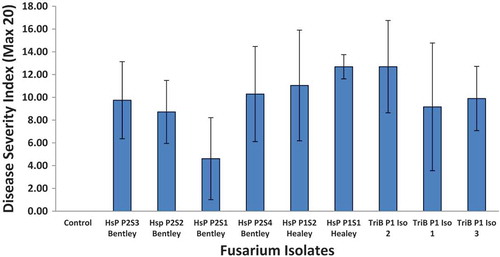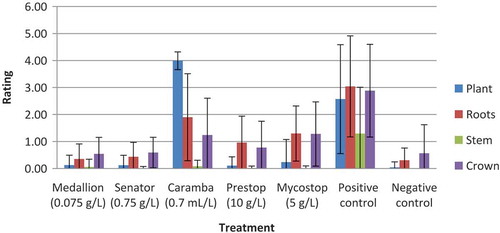Figures & data
Fig. 1 (Colour online) Colonies, conidia and development of F. oxysporum on greenhouse ‘Fascinato’ pepper following inoculation. (a) 14-day-old cultures of F. oxysporum on aPDA. (b) Hypha and lateral subcylindric monophialides with conidia (arrows), scale bar = 8 μm, (c) 1, 2, 3, and 4-celled conidia, scale bar = 8 μm, (d) Greenhouse ‘Fascinato’ pepper plants: healthy, uninoculated (left) and plants with severe symptoms (right) (red arrows), 77 days after inoculation. The affected plants are stunted, the leaves are wilted and necrotic. (e) Foliar chlorosis originates from the leaf apex and in leaf vein tissue of lower leaves. (f) Later stage of disease development includes foliar necrosis starting from the lower leaves. (g) Crown tissue from control, water-inoculated ‘Fascinato’ pepper plants shows no internal stem damage, healthy white roots and no crown damage. (h) Crown tissue from ‘Fascinato’ pepper plants inoculated with Fusarium oxysporum shows significant black and brown discolouration (red arrow), roots that are dark brown or black and in many cases decayed (red arrows) and minor internal stem discolouration. (i) Dark brown, external stem discolouration (red arrow) at the base of the ‘Fascinato’ pepper plant.

Fig. 2 (Colour online) Combined DSI from two experiments of ‘Fascinato’ pepper plants inoculated with various isolates of F. oxysporum. Error bars denote standard deviation (n = 4).

Fig. 3 Gel electrophoresis of PCR amplified greenhouse pepper isolates of F. oxysporum from the first site (TriB-P1- Iso 1, 2, 3) and five isolates from the second site (HsP-Bentley-P2- S1, S2, S3, S4; HsP-Healey-P1- S2) as well as an isolate each of F. oxysporum f. sp. lycopersici and F. oxysporum f. sp. radicis-lycopersici. DNA extracts of individual isolates were PCR amplified using TEF forward and reverse primers. PCR amplicons were run on a 1% agarose gel containing 8.5 μL of Invitrogen SYBR Safe DNA gel stain. The isolate lanes are as follows: 1 = blank, 2 = Fusarium oxysporum f. sp. lycopersici, 3 = Fusarium oxysporum f. sp. radicis-lycopersici, 4 = HsP P2S3 Bentley, 5 = TriB PI Iso 1, 6 = Check – 100 bp DNA Ladder, 7 = HsP P2S1 Bentley, 8 = HsP P2S2 Bentley, 9 = TriB P1 Iso 3, 10 = TriB P1 Iso 2, 11 = HsP P1S2 Healey, 12 = HsP P2S4 Bentley.

Table 1. Efficacy of various fungicides and biological control products for control of Fusarium crown and root rot incited by Fusarium oxysporum measured using disease severity index (DSI) in greenhouse ‘Redwing’ peppera.
Fig. 4 (Colour online) Response of various greenhouse pepper cultivars and lines, as measured by disease severity index, to three isolates of Fusarium oxysporum. Disease Severity Index (DSI) = Root + Plant + Stem + Crown ratings. Each rating is a maximum value of 5 with four different ratings for a possible maximum disease severity rating of 20. Error bar represents the standard deviation.

Fig. 5 (Colour online) Combined mean ratings of trials 1, 2 and 3 for plant, roots, stem and crown tissue of ‘Redwing’ greenhouse peppers following treatment with reduced-risk materials for control of F. oxysporum. Positive control = fungus-inoculated; Negative control = water only. Error bars denote standard deviation.

